If you’re familiar with content marketing, you’ll know that it goes far beyond writing blog posts. We’ve helped our clients produce a wide-array of content formats across virtually every industry to drive traffic, engagements, and conversions. Get in touch with us for a free, no-obligation quote.
Using a variety of content formats has been proven to help diversify traffic and keep the audience engaged.
If you’re looking to spice up your blog by experimenting with new formats and new content marketing strategies, then you’re in the right place. We’ve listed down all of the blog or site-hosted content formats you can create, and organized them into five main categories namely Blog Posts, Graphic Posts, Video and Audio, Downloadable or Onsite Documents, and Interactive Assets.
Note that some formats can be classified into multiple main categories. However, we decided to categorize specific formats to a single main category based on the difficulty level of creation and the type of format where its value can be best maximized.
With almost 100 types of content listed here, you’ll never run out of ideas for your blog anymore. You can even experiment by combining some of these formats. Just remember that effective content marketing is not about producing the longest, most colorful, or most modern content. It’s about finding the right content format that’s valuable for your audience, created and published at the right stage of the buyers’ journey, and distributed on the right channels.
Main Categories:
Blog Posts
Graphics
Video and Audio
Documents (Downloadable and Onsite)
Interactive Formats
Blog Posts
- Listicles
Listicles, a portmanteau of the words list and article, are short articles that list down samples, reasons, or factors about a specific subject. It can be in a random order like our “50+ of the Best B2B Content Marketing Resources: Articles, Guides and E-books for Beginner and Advanced Levels” or a ranked one like Billboard Hot 100.

Due to its lack of need for a flow or structure and the ease of creation, listicles have been a favorite of many content creators to the point of quality neglect. If you’ll notice a lot of Buzzfeed listicles only include a one sentence description for every point.
If your goal is simply to entertain people like Buzzfeed, then putting in minimal effort is okay. But if you have more business-oriented goals, then you have to make sure that your idea is original and valuable to your audience.
Tip: A research by Betaworks showed that 29 is the most ideal number of listicles. Large numbers ending in 1 also perform well.
Difficulty Level: 1
- How-tos
Short articles explaining how to accomplish a specific task are called how tos. It’s usually broken down into the major steps needed to perform the task. Topics can range from the most basic like How to Clean Your Laptop’s Case, Screen, and Keyboard to more advanced like How to Use Pinterest to Effectively Build Links to Your Infographics.

The important thing to remember when writing how-tos is to make the narrative as simple as possible for your readers. This is because readers might have different levels of understanding about your subject matter.
Tip: When writing the headline of your how-to content, focus on explaining the benefit of doing the task to your readers and not just the task itself. For instance, instead of using “How to Commute Around Metro Manila,” try using “How to Commute Around Manila to Save ₱20,000 Year.”
Difficulty Level: 1.5
- Guides
Not to be confused with how tos, as guides are more detailed discussions about a specific subject. Some of our favorite guides are Link building: The definitive guide and A Guide to Evaluating Your SEO Strategy for B2B Lead Generation.

Aside from presenting a step by step process, guides usually explain even the most basic concepts for the benefit of first-time readers. The most successful guides are usually described to be the best in the industry by including adjectives like Ultimate, Definitive, or Complete in the headline.
Tip: Guides are impossible to be consumed in one sitting. Make it easier for your readers to navigate your content and return to where they left off by dividing your guide into multiple sections or chapters.
Difficulty Level: 3
- Long forms
There has been a debate on what should really be considered a long form content. You and your team can have your own definition, but in our book, long forms are articles with more than 2,000 words. This type of content appeals to readers who are seriously researching about a specific topic.
You might have read somewhere before that people are more receptive to bite-size content. However, if you want better engagement and page rank, long form content like Is SEO Dead? and Nature Has a Formula That Tells Us When to Die might be the perfect format for you.

Tip: Incorporate images to break the wall of text that your readers have to go through. Subheadings are also very important to guide your readers on the flow of the discussion.
Difficulty Level: 2.5
- Myths vs. Facts
Presenting, proving, and debunking myths with the help of facts is particularly helpful for content marketers working in technical industries like health and technology.
A few great examples are Caffeine Myths and Facts from WebMD and HTML5: The Facts and the Myths from Smashing Magazine.
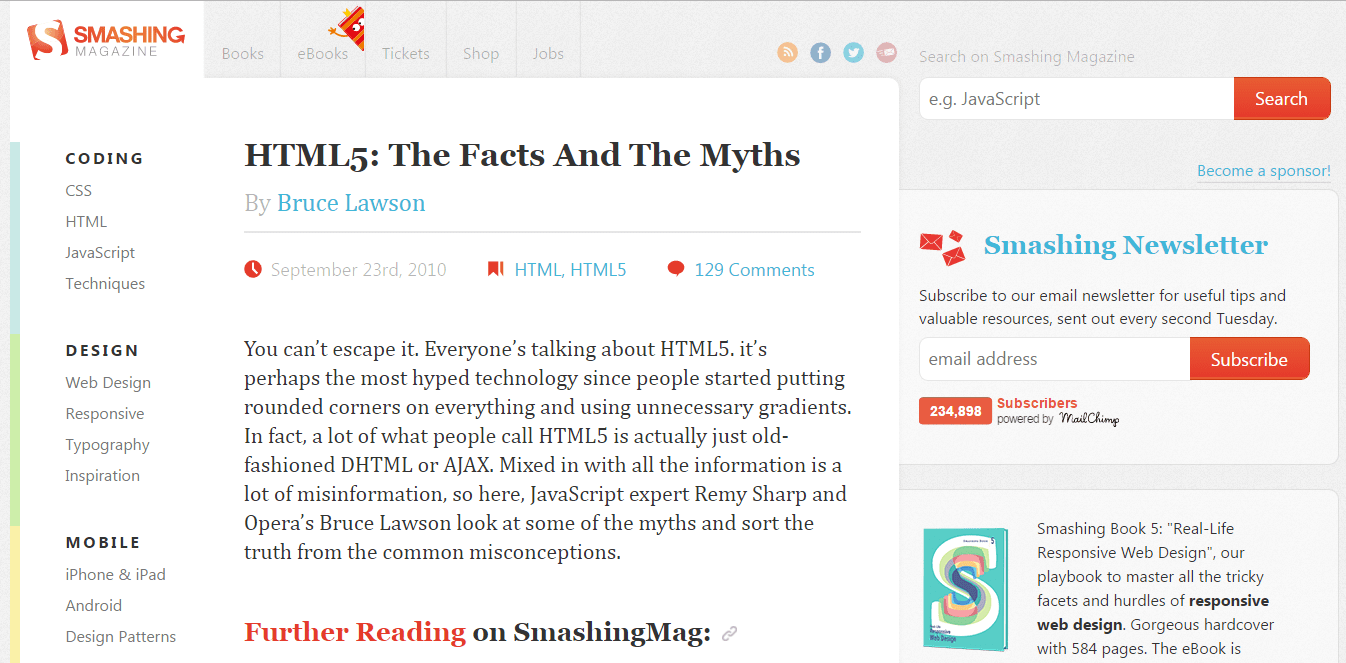
Tip: Aside from presenting the facts in contrast or in support of the myth, you should also provide advice on how readers can take advantage of this new knowledge.
Difficulty Level: 1.5
- Facts and Stats
Collecting facts and statistics about a topic is one of the easiest ways to produce highly linkable content. Just be cautious when selecting the figures you want to include in your content. Make sure that they are from credible sites and the data are updated.
Marketing Automation Statistics for 2021 and 10 Insightful E-commerce Statistics for Businesses are two great examples of this content format.

Tip: Make it easy for your readers to share every fact or statistic by adding a click to tweet option.
Difficulty Level: 1
- Tips
If you want to establish yourself as an industry expert, consistently writing tips on your blog can help you do that.
Some of my personal favorites are blogs by Venture Capitalist Mark Suster and Digital Marketing Guru Neil Patel.

The key to writing tips is to make the articles uniquely your own. Your tips and advice should come from your personal experiences to make sure that your audience relates to you.
Tip: Encourage a healthy discussion from your readers by asking for their personal take on the topic you discussed.
Difficulty Level: 2
- Best Practices
By definition, a best practice is a technique or methodology that has been proven to give the best results. By listing down best practices in your industry, you are sharing and displaying your expertise in your field.
Check how Best Practices for Email Subject Lines and Best Practices: What is the Optimal Length for Video Content were written.

Tip: Illustrate the impact of following the best practices by sharing how your company benefited from following them.
Difficulty Level: 1.5
- Best/Worst
Instead of presenting a list, you can also present the best or worst way, reason, factor, outcome, etc. about your topic. This type of content works if you have a lot of things you can discuss regarding that single subtopic.
To make the article more interesting, the main topic should not be revealed in the title like The Best Way to Win an Argument and This is the absolute worst reason to be bullish on stocks right now. It’s a bit link baity but it works.

Tip: This doesn’t work if there are other things that can arguably replace your main topic.
Difficulty Level: 1.5
- Explanation
A perfect example of this content is the article This Is Why Poor People’s Bad Decisions Make Perfect Sense. It’s a thought-provoking piece that dished out several reasons poor people make bad choices. Another approach is to explain a controversial event like Here’s Why Samsung Note 7 Phone’s Are Catching Fire.

Tip: If you’re trying to explain a highly technical topic, it’s best to support your article with images or videos.
Difficulty Level: 1.5
- Problem Probing
If explanation articles try to give a reasoning behind a pattern, decision, or event, then problem-probing, on the other hand, helps the readers realize that there are problems in certain situations.
This usually works when you’re pointing out a problem with a positive or generally favored topic like The Problem with Satisfied Patients.

Tip: At the end of your article, you can either suggest a possible solution or solicit them from your readers.
Difficulty Level: 1.5
- Alternative Suggestion (This, Not That)
Though more popular as a food recommendation article, the alternative suggestion can work for technical topics like finance, IT, health, and even beauty.
Just take a look at how Drive This, Not That: 10 Pricey Autos and Their Cheaper Counterparts and Why We Use Branding to Pull, Instead of Sales to Push presented the contrast of two different options.

Tip: Though bias is difficult to eliminate when writing suggestions, try to present your case objectively by supporting it with data and stories.
Difficulty Level: 1.5
- What Not To Do/ Negative Results
Research have shown that content with negative headlines perform 30% better than those with positive headlines.
Take advantage of that by spinning your article in a negative way similar to 50 Ways Social Media Can Destroy Your Business. You can also present a case study with negative results just like How We Failed to Reduce Email Overload Using the Project Management Tool Asana.

Think of it as a way of sharing your company’s bittersweet lessons and displaying your longevity and tenure in the industry.
Difficulty Level: 1.5
- Comparisons
Writing comparative articles can also be a way to display expertise in your industry. You can compare tools, services, personalities, and more about your industry.
Take note that comparative articles work better if you’re comparing only two (Who Versus Whom ) or three (TV Streaming Head-to-Head: Netflix vs. Hulu vs. Amazon Prime) items. Some four-item comparisons like Link Building Outreach Platforms Compared can work as well, as long as the data is presented clearly. If you want to compare more than four items, the best option is to do a listicle with pros and cons or divide it into multiple comparative articles.

Tip: Make it easier for your readers to arrive at a decision by presenting a summary of data side by side by the end of your article. You can use a table or an infographic for this. (Link to comparative infographic part)
Difficulty Level: 2
- Roundup
A roundup is simply a collection of articles published by related websites in your industry.
There are multiple ways to present a roundup to make it appealing to readers. The easiest is to make a list with an introduction paragraph. You can also write a short description for each article that you included in the write-up or go as far as writing a new article that incorporates every article in your roundup. Roundups can also be published weekly, monthly, or annually.
Just remember that the goal for a roundup is to give your readers a faster way to consume content, so think of them when planning how you’ll present your roundup.
A few of my favorite roundups are Digital Marketing Weekly Roundup, Freshly Picked: Link Roundup, and Top 25 Inbound Marketing Articles of the Week.

Tip: Choose a weekly or monthly theme if your industry has an active content marketing community.
Difficulty Level: 1
- Question & Answer (Q&As)/Expert Interview
One of the main goals of blogging is establishing thought leadership. This can be difficult if you’re a young company and your executives are not yet known in the industry. But who says you can’t borrow some premium from industry experts? That’s right. Publishing interviews with influencers from your industry can add a lot of credibility to your site.
The more amazing thing about expert interviews? It just takes a few email exchanges to create one. The most difficult part is securing the approval of the interviewee. But once they agree to do the interview, you simply have to send a set of questions that he/she can answer through email or a recorded phone interview.
Just see how these two interviews, Interview Q&A with The Martian Author Andy Weir and Expert Interview Series: Mike Lagman of Spiralytics Inc. on digital marketing strategies, were formatted.

Tip: The key to a good interview article is the flow of questions. Organize your questions to make the flow of the discussion smoother. This will prevent you from editing the original transcript too much, and making the article look more organic.
Difficulty Level: 1.5
- FAQs
Frequently Asked Questions or FAQs have the reputation of being boring, but that’s because people usually associate it with questions about a company’s product or service. Going back to the basic definition of content marketing, content has to be valuable to your audience for it to work.
In this case, instead of product FAQs, you can write one about the common questions in your practice or industry like 10 Beginner Yoga FAQs Answered, or the questions and answers about a popular event like Election Hack Report FAQ: What You Need to Know.

Tip: You can find FAQs from the comments section of your blog, your social media, or industry forums.
Difficulty Level: 1.5
- Testimonials/Customer Success Stories
This is not the typical one-liner testimonials you put on your homepage. These are the in-depth testimonial stories that will give your audience a better understanding of how your product or service can help them with their problems.
This type of content can be particularly helpful to readers looking for a last push to purchase your product. Furthermore, it can serve as a referral letter to companies who also believe in your clients.
Zapier and Altify are companies that create compelling testimonial blogs.
Tip: Give out incentives to previous customers in the form of discounts or freebies for them to share their stories.
Difficulty Level: 1
- Reviews (Includes book reviews)
Writing reviews may seem appropriate for individual bloggers and not for companies. But if your company uses and truly believes in specific products or services, then writing a review can work for you.
For instance, Guthrie-Jensen listed down the best management and leadership books that their trainers use. Meanwhile, this review by Event Manager Blog for the tool GenieConnect is a sponsored review, but was disclosed in the article.

Tip: Writing reviews is about being truthful. Remember that you are writing an endorsement for a product which gives you the license to warn your readers about the potential problems they may encounter when they buy the product or avail of the service.
Difficulty Level: 1.5
- Buyer’s Guide
While reviews focus on specific product/s or service/s, a buyer’s guide gives pointers that your audience should consider when deciding on a product or service. You can still mention some specific options, but the discussion should revolve around the factors.
This is a popular format for tech blogs just like Laptop Magazine’s Laptop Buying Guide: 8 Essential Tips. This example from Paragon, on the other hand, is a guide to choosing a service provider.

Tip: There are many factors to consider when deciding on a product or service. Make every factor clear in your discussions by giving your opinion on the weight of each factor.
Difficulty Level: 2
- Company Update
Most company updates are self-serving. But if the material and angle are both interesting, they can be relevant not only to journalists in your industry, but also your primary audience.
Offer a reason how your app update can help them with their problems or how the new certification improves the service that you offer.
ThisWay Global launches AI software platform to transform the recruitment industry is a great example for this.

Difficulty Level: 1
- Company Goals
While company goals seem better off in the “about us” page, showing progress in achieving your goals like Grover’s blog can certainly make you a standout among your competitors. They wrote how they achieved specific milestones in every blog post to convert readers into customers.

Difficulty Level: 1.5
- Industry Update
Newsjacking an industry update or an update by a major player in the industry is one of the best ways to get quality visitors on your site.
The key to newsjacking is to release your story before everyone else publishes theirs. Simply follow the five steps of newjacking from Hubspot:
- Set up alerts
- Check keyword search volume
- Read about your topic
- Write quickly but accurately
- Differentiate yourself
- Get the word out
A timeless example would be the London Fire Brigade’s offer to train Kate Winslet after the actress saved Richard Branson. By riding on a positive news, they were able to promote their firefighting training for women.

Difficulty Level: 1.5
- Industry Insight/ Opinion
It takes a certain level of expertise to come up with a unique and thought-provoking opinion piece about an industry update. But if you could do it, then you don’t have any excuse not to do so.
The nice thing about writing an opinion piece is you don’t have to follow any guidelines or format. You simply have to present your case very convincingly. And you don’t have to convince everyone. The more polarizing and fresh your insight is, the more effective your content will be.
Just take a look at the article, Social media is protecting men from periods, breast milk and body hair. Almost half of the commenters tried arguing with the writer and other readers because the topic was never discussed publicly before.

Tip: Consistency is the key when producing opinion pieces if you want to be a thought leader. Make sure to write consistently and write with a consistent style or voice.
Difficulty Level: 2
- Industry Predictions/ Analysis
This is somewhat similar to industry insight or opinions. But unlike the prior, you have to present data that shows a trend that could lead to your analysis or prediction/s.
This type of content is appropriate for industries that deal with a lot of data like recruitment, marketing, technology, and communication, among many others.
This article from Wordstream titled 9 Crazy Predictions for SEO in 2017 used various data they collected and recent actions by Google to predict changes in SEO.

Difficulty Level: 2
- News Hub
A news hub is a page dedicated to hosting important industry news. You can set this up as an aggregator page, or you can republish news stories from related sites.
Here are a few examples: Accessories Magazine, Magic Bricks, and Digital Agency Network.

Difficulty Level: 1.5
- Recap (Year-ender, Events, Season)
A recap article is a summary of anything that happened in an event, season, or even a whole year. This is particularly helpful for readers who were not able to attend an event or for those who like to read a roundup of the industry changes in the year or a collection of lessons, elements, industry players in a certain season like The 45 Most Creative Infographics of 2016 and HubSpot’s Inbound 2017 Recap.

Tip: The key to a successful recap is the release date. You have to be first to release the story right after the event or right before the start of the new season.
Difficulty Level: 1.5
- Report Breakdown/ Highlights/ Analysis
A lot of readers don’t like reading long reports or documents. If there’s a prominent annual study or whitepaper in your industry released by a major player, ride on their content by creating a breakdown, highlight, or analysis.
Not only will you be able to get on the good side of the major industry player in helping them promote their content, but you’ll also get a timely and interesting content for your own blog too.
The 6 Most Important Takeaways From CMI’s Annual Study is a great example from the digital marketing industry.

Difficulty Level: 2
- Research/ Experiment
When people think of research, they immediately think of a massive undertaking that involves a lot of resources. Nowadays, research could be as simple as looking at your own data like the performance of your clients or the answers of your customers to your 10-question survey.
The thing with research is that as long as the method is credible and the data is interesting, numerous people in the industry and your audience will take notice. Thus, giving you more credibility as a thought leader.
You can take on a massive research like Jobstreet’s Annual Salary Report or simply analyze readily available data like OKdork’s We Analyzed Nearly 1 Million Headlines. Here’s What We Learned and still have great results for your brand.

Tip: If you see a good response from the audience with a specific type of study, try to do it, at least, annually.
Difficulty Level: 2.5
- Public Service Announcement
Does your company have a social cause that it regularly supports? Why not publish a PSA or Public Service Announcement?
Take a look at this brilliant example from Bitcoin encouraging their community to voice out their opinions.

Difficulty Level: 1
- Open Letter
An open letter is a piece of content written in the second person for a specific audience. It can be directed to the customers, peers in the industry, the government, other organizations, or a leader.
It’s usually written to appeal or shed light on a certain issue. Check out this open letter from Maintainers of Open Source Projects to Github to which the company also wrote back, and this piece from scientists to President Donald Trump about climate change.

Difficulty Level: 1
- Advertorial / Co-branded
Partnering up with non-competing brands in your industry can give you endless ideas for content.
You can also open your blog to advertorials from other companies.
Simply set parameters on how “promotional” the content will look like and make sure that advertorials are distinguishable from your own content.
Difficulty Level: 1.5
- Guest Posts
Guest-posting is a popular promotional tactic where a writer contributes to other sites to get exposure and links.
Open up your blog to credible Guest Authors in your industry. It’s a great way to earn links and establish a relationship with authoritative bloggers. Some websites don’t merely accept guest posts. Rather, they connect with top industry bloggers and ask them to write or, even better, collaborate on content.
Just make sure that you establish a clear set of guidelines on who can qualify as guest authors and what type of content you’re looking for. After all, even if others wrote the content, you still own the media. That’s why the content has to resonate with your target audience.
Some of the most popular guest-posting sites in the digital marketing industry are CopyBlogger, Small Business Trends, and Marketing Profs.

Tip: Make it clear to contributors that, as the owner of the site, you still hold the final decision when it comes to editing and publishing their work.
Difficulty Level: 1.5
- Glossary of terms/ Definitions
If no one in your industry has published a glossary of terms or definition of terms, then you better make one now. This is a great opportunity to earn links and establish your blog as a credible resource in the industry.
Check out Nasdaq’s Stock Market Terms Glossary and Thompson and Morgan’s Glossary of Gardening Terms for inspiration.

Tip: Open your page to comments from your reader to know if you need to update the page with terminologies you forgot to include or newer terms that just came out.
Difficulty Level: 2
- Industry Directories
Creating an industry directory is a massive undertaking, but this is also a great way to get both quality traffic and links.
There’s always the option to narrow down your directory to a specific niche to reduce the amount of work similar to For Construction Pros focus on Asphalt Industry directory.

Tip: A common mistake of directories is allowing users to add their sites without review and approval, making their site less credible. Regularly schedule reviews for all directory submissions to maintain the page quality.
Difficulty Level: 3.5
- Links Pages
A lot of links pages come out spammy due to the lack of focus. When creating a links page for your site, decide first on what your links page should be about and how it can help your site.
A safe topic for a links page is a list of helpful links in your practice like Bay Area SEO SMO and 115 Killer Resources to Hack Your Inbound Marketing Success. You can also try a list of articles that will serve as inspiration for marketers in your industry.

Difficulty Level: 2.5
Graphics
- Photos
Photos are not stand-alone content formats, but they can greatly enhance the experience of your readers. You can download them for free from these sites or buy from popular stock photo sites, but the best type of photos are those that are taken by your brand for your brand. You don’t have to pay for them, and you own them.
Jon Loomer is probably the best example for this. He markets himself as a Facebook Advertising expert by using his face on all his blog banner photos.

Difficulty Level: 1.5
- Photo Slides and Photo Galleries
Telling a story through photographs can be best achieved by using photo slide or photo galleries. Take inspiration from these amazing executions by Fast Company, Planet, and Lego.

When publishing a photo series, make sure that every photo relates to each other and everything looks cohesive when viewed as one. Try to use one source/photographer and edit your photos to look and feel the same to achieve continuity.
Tip: User experience should be the top priority when publishing photo slides or photo galleries. Most plugins take a lot of time to load or are not mobile friendly. Test your page on different devices before publishing. Remember to optimize the size of your images too for faster loading.
Difficulty Level: 2
- Quote Cards
Inspirational content like quote cards will always be appreciated by anyone regardless of your target audience since they are nice to share on social media. The Marketing Spark used to regularly publish quote cards every week.

Tip: Don’t just grab quote cards from other sites. Make your own and make them uniquely your own. This can help with your brand goals even if your content gets passed around.
Difficulty Level: 2
- Slideshows
A slideshow is a series of still images presented in sequence to demonstrate or explain a subject matter. The easiest way to create one is by uploading a presentation on Slideshare and embedding it on your blog post. You can also make the presentation available for download in a pdf or powerpoint format.
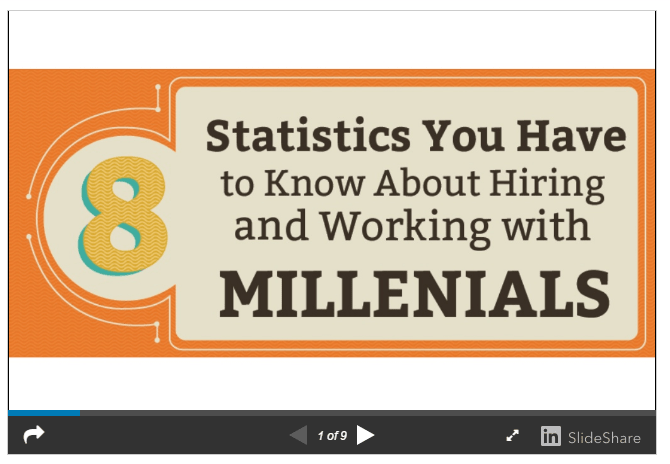
Tip: You can always include links and Call to Action (CTA) on the last slide of your presentation to lead them back to your site in case another site uses your content.
Difficulty Level: 2
- Posters
Posters are making a comeback in the digital sphere, and you can make a set just like NASA. The government agency website releases a series of printable poster to promote every new project launch to the media, younger generation, and Space and Aeronautics fans. Check these samples.

Difficulty Level: 2
- Graphs and Charts
As I’ve emphasized before, user experience is very important in choosing a content format. If you have tons of data from your research, you can’t simply present them in a word format or use tables. Go a step further by creating graphs and charts that will make your data more appealing to the readers.
Line graphs, pie charts, bar graphs, and the like can help you prove and illustrate your points. Take a look at these samples from APEX and Wordstream.

Tip: Make your brand shine through your graphs and charts by using your company’s color palette.
Difficulty Level: 2
Infographics
For the past few years, snackable content has been a hit for a lot of industries due to the shorter attention spans of the audience. Infographics is one of, if not the most, popular snackable content nowadays, as it can summarize your main points in a single image using fewer words.
Here are the most common types of infographics that you can create. Note that all of these can either be static or animated.
- Mixed Charts and Graphs
Does your audience love data but don’t have time to read a whitepaper? You can create an infographic containing multiple charts and graphs. Take a look at these examples from Emergency Food Storage UK and James West’s The Fragmented World of Digital Music.

Difficulty Level: 2.5
- Pictograph/ Single Chart
Pictographs are infographics that focus on a single image to discuss a topic. It uses less text compared to other formats. Here’s an example from Capstone about Titanic and Fandango about the Anatomy of Sharknado.

Difficulty Level: 2
- List
As the name suggests, infographic lists simply list down samples, types, or different points in an image. This type heavily relies on text to discuss the topic much like SpreadBetting’s list of richest hedge fund investors.

Difficulty Level: 2
- Hierarchical
If your topic revolves around levels or structures, then a hierarchical infographic is perfect for you. This can be in the form of a pyramid like Successful College Student’s Pyramid or a branching out chart like Amazon’s Acquisitions and Investments.

Difficulty Level: 2
- Timeline
Display a sequence of events or a change over a period using a timeline infographic. Dates and events should be visualized using images displayed in the proper order. My favorite example of this is the infographic on How Elon Musk Started.

Difficulty Level: 2.5
- Comparison
Comparison infographics can be used as a stand-alone or a supplementary content. Unlike comparative articles, infographics can only have a limited number of elements to be effective. The optimal subjects you can compare are two or three.
Here’s a great example of comparing two elements in Samsung Galaxy Alpha versus Samsung Galaxy S5. This infographic titled Junk in the Trunk compares three Content Management System Platforms.

Difficulty Level: 1.5
- Maps
Whenever you want to show data or trend about different locations in a specific region, you can use this type of infographic. Data is usually represented by color assignments or icons. Check this map from Flowing Data showing the most popular pizza chains in the US.

Difficulty Level: 2
- Instructions or How-to
Also known as instructographics, this type of infographic illustrates step by step process to accomplish specific tasks. This is common among DIY blogs like this infographic series about fishing projects.
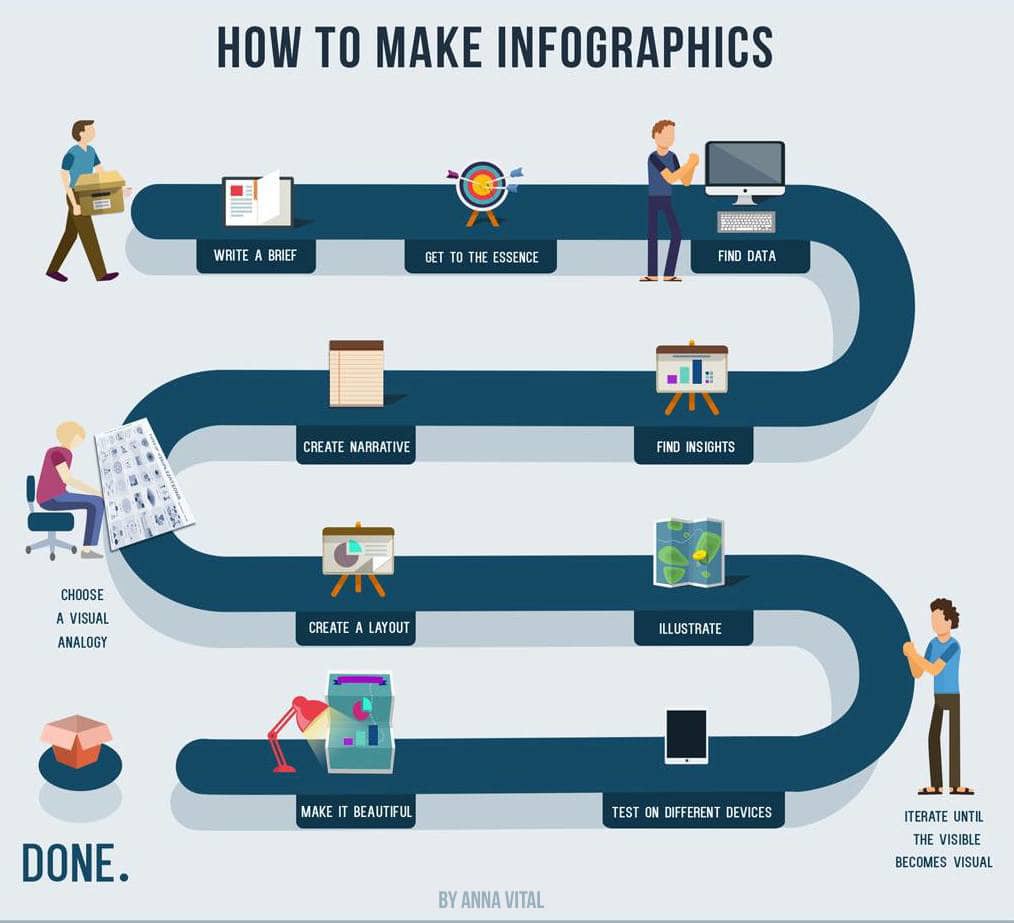
Bonus: Here’s an infographic on how to make infographics.
Difficulty Level 1.5
- Process
Actual processes can also be documented into infographics. This infographic titled How a Pope is Elected is one of the most detailed process infographics I’ve seen.

Difficulty Level: 2
- Interactive
Not to be confused with animated infographics, interactive infographics are pages designed for immersive learning. Each action can result in a movement or an appearance of an image or text. This is usually created if you have too many data that can’t fit a regular size static infographic.
Instead of explaining it further, just see for yourself what an interactive infographic looks like with these examples: Evolution of the web and The New New York Skyline.

Difficulty Level: 5
- Photographics
Some subjects can be difficult to translate into symbols or icons. In these cases, you can use photographs for your infographics. Millennials Want Healthier Snacks and The Pie Chart of Pies are just a couple of great examples.

Difficulty Level: 2
- Timeline
We’ve already discussed timeline infographics. But, what if your timeline is too long to be contained in a single image?
You can create a page that can scroll vertically or horizontally to display all of the details in your timeline. Take a cue from the official website of Anne Frank and Akita’s A Visual History of Computers.

Difficulty level: 4
- Diagrams
Taking on an academic approach can also work for your blog. If you have complex ideas to present, you can utilize diagrams to represent this type of information.
Difficulty level: 2
There are also other ways to execute diagrams as follows
Illustrated
Illustrated diagrams are easy to execute since they only require basic skills in using image editing software. You can even draw your diagrams and scan them just like this post from Andriy Buday.

Difficulty level: 1.5
Computer Generated (Nodes)
Nodes, from its most basic definition, are data points on a larger network which show relationships between different points. This has been widely used by news publications who track social media conversations like this article from Rappler.

Difficulty level: 1
Decision tree-Diagram
Though this can be considered as a type of diagram or an infographic, the decision-tree diagram is one of the types of images that can stand on its own. It is usually directed at readers who are already at the decision stage or bottom funnel of your content marketing like this infographic from LaCure Villas that helps travelers choose the next trip destination. You can also tackle common issues like Wrike’s Should We Have a Meeting.

Difficulty Level: 1.5
- Memes
Memes started out as social media content that has worked its way into blogs. They are a favorite among marketing bloggers because they can be easily customized, and can lighten technical topics.
Experiment using sites like Meme Generator and Img Flip to create your own memes.

Tip: You can’t just use any meme for any situation. Each meme has a significant origin which can explain its proper use. Research other executions before using one.
Difficulty Level: 1
- Comics
The use of comics can be entertaining breaks from your technical and serious content. They can be funny, sarcastic, or even dark. As long as they can send your message across, they can be very effective.
For marketers, marketoonist is undoubtedly the most popular source of hilarious and relatable comic about marketing.

Difficulty Level: 3
- Animated GIFs
Similar to memes, animated GIFs originated from the social sphere. While they have limited applications, using the appropriate ones can make your content more memorable. These can also show your personality as a writer based on the movies or tv shows where your gifs came from.

Difficulty Level: 2
- Handwritten sketches, drawings, diagrams
If you’re not very adept at using image or illustration tools, you always have the option to do something by hand and scan it later to transform it into a digital format.
Hugh MacLeod started his blogging career by drawing on paper napkins, which set him apart from other marketing bloggers during his time.

Difficulty Level: 1.5
- Comparative Image sliders
You’ve probably seen one of these on Buzzfeed. They are usually used to compare two different executions or phases of the same subject.
In the article 34 Celebrities Who Share The Same Face, two celebrities are compared side by side to see the similarities in their faces.
Before and after photos can also be compared as in the case of 28 Before And Afters That Show The Transformative Power Of Makeup .

Difficulty Level: 3
- Parallax Storytelling
Brand stories can be executed in a less promotional way – through one-page parallax designs. The War of the Decade a 10th anniversary page for web design company, Maze Solutions, is an award-winning page that narrates how the company battled boring web designs in a quirky way.

For a more serious sample, you can check out Junko’s Story: Surviving Hiroshima’s Atomic Bomb.
Difficulty Level: 4
- Mindmap
A mindmap is a type of diagram inspired by brain neurons. The center represents the main topic that branches out into multiple subtopics. It is usually used to illustrate the single relationship among different information.
Here’s a mind map on how to create mind maps from GoConqr.

Difficulty Level: 1.5
Video and Audio
- Interviews
Although interviews can be executed through a regular blog post, using a video or audio can be a more optimal format, as audiences today want easier ways to consume information.
You can have regularly scheduled interview podcasts like Agile Marketing’s Interview Series or interview influencers from the industry whenever there’s an opportunity.

To get more interview opportunities, make sure that you actively participate in events in your industry. You’ll most likely meet people who are interested to talk about themselves and their work in these locations.
With the myriad of available communication and recording tools like Skype and screencast, you’ll always be assured of the quality of your content.
Tip: To help your SEO, transcribe the interview and include it in the blog post.
Difficulty Level: 2
- Demos
Many SaaS companies offer tutorials on how to use their software. They usually demonstrate these by creating screen-recorded demo videos.
If you have an interesting product or service, you can release a video series showing the different uses or executions. How Link Prospector in 2 minutes is a great example of a screen-recorded demo video from Citations Lab.

Demo videos don’t always have to be technical like GoPro’s revolutionary user-generated video campaign showing how the product was used by their customers.
Difficulty Level: 3
- Explainers
Unlike demos, explainer videos don’t show a step by step process to use a product or a service. They only explain how it works in a general sense and its possible benefits to the consumers. Thus, require great storytelling
It’s best to check samples like What’s Pinterest?, Olark, and Zazzle. Notice in all the examples how they managed to put the consumer in the story and not their brand.
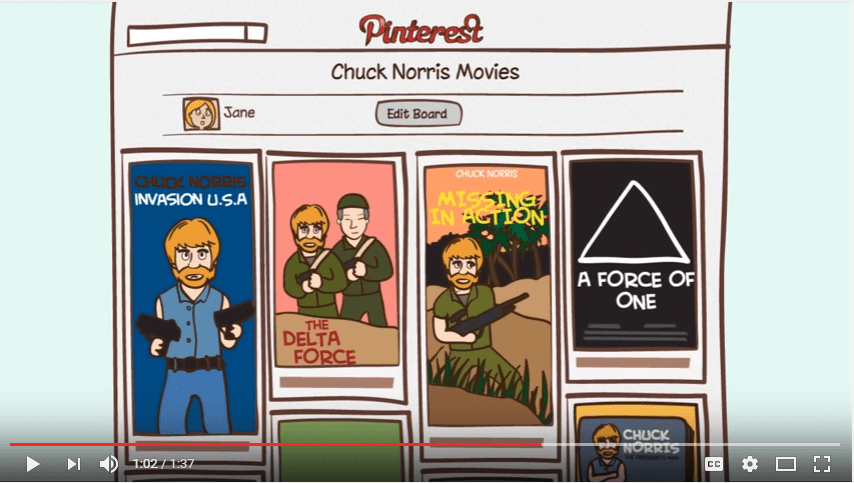
Tip: To create a story around your product, think of the most common pain points of your customers and how your product can address these pain points.
Difficulty Level: 3.5
- Tutorials
Probably the most common video content format for brands, tutorials are content used to transfer knowledge about more advanced uses of the services or product, additional tips, and industry best practices.
In digital marketing, Moz‘s whiteboard Fridays is undeniably the best example. Since Rand’s first video in 2007 about the importance of meta tags, the company never stopped releasing videos every Friday.

Though remarkably simple, the tutorial series has earned its place in the industry as one of the most reputable resource for anything SEO-related.
Tip: Much like whiteboard Fridays, your tutorials don’t have to be flashy to work. After all, it’s the lessons your audience is after.
Difficulty Level: 3
- Web Series
Got a brilliant tv series idea for your brand that you think has the potential to be a hit? Why not create a web series?
Web series are shorter versions of your regular television series published directly on the web which indirectly promotes a brand through product appearances.
Web series can have an indefinite number of episodes like Denny’s Always Open. It can also have a specific number of episodes like Nike’s Margot vs Lily.

Aside from product placements, successful web series usually resonates the value of the brand.
Tip: Research has shown that viewership declines overtime. Allot enough advertising budget for the last episodes for a more balanced result.
Difficulty Level: 5
- Talking Head Video
Talking head videos are the simplest and most straight-forward video content format you can execute. Just write a script for one of your talents to deliver in front of a camera, do some editing, and you’re all set to publish.
Most of the time, talking heads discuss benefits and some tips to fully maximize a product similar to a classroom lecture. It’s usually best accompanied with some graphics or an inset video to help illustrate the points of the speaker.
Before Tony Robbins started recording his speaking engagements for his online content, his videos were mostly just him on a white background delivering the inspirational speech in front of the camera.

Tip: The on-screen talent is one of the most crucial factors that can make your talking head video a success or a failure. He/she should have the charisma and eloquence of tv presenters.
Difficulty Level: 2.5
- Webinars
Webinars have recently become a popular content format for many digital marketers. This is because of the grandness of the content without the grand budget.
You’ve probably received invitations from the likes of Neil Patel to attend an online seminar headlined by top marketing gurus to talk about a specific topic from a remote location at a specific schedule.
Just like a regular seminar, webinars should follow an event flow. Normally it’s broken down into several subtopics, and each speaker is assigned to talk about his/her expertise. If you’ve never attended a webinar, it’s best if you could check the webinars from Harvard Business Review.

Most of these webinars are free of charge, but users have to pay extra if they want to have access to recorded sessions of the webinar. Some of these webinars are live and others are marketed as live but has already been recorded.
You can offer it for free or require the target audience to do a task before they can attend the webinar. This will all depend on your goal.
Tip: Since webinars are just like regular seminars, you have to account for the creation of collaterals including webinar software, event pages, and payment for the speakers in your content marketing budget.
Difficulty Level: 5
- Virtual Events/ Live Streaming
Many companies are now maximizing their events by allowing their audience from other locations to attend virtually through a live broadcast. Aside from extending the value, companies use these events to generate leads.
The most common forms of virtual events are trade shows, job fairs, and conferences. These are usually broadcasted using a one camera setup and a livestream tool.
Virtual events can also refer to a virtual world created by recording videos from an event so that viewers can have a virtual experience anytime.
Difficulty Level: 4.5
- Interactive Video
If your audience is already bored with regular videos, try experimenting with interactive videos. These videos are normally shot from the point of view of the viewer to make them feel like the central character in the story. It can have multiple outcomes based on the goal of your video.
This recruitment video from Deloitte was taken from the perspective of a potential employee to test if the viewer is a fit for the company. It has four sections that represent each of the core values they look for in potential employees.

Difficulty Level: 4
- Virtual Tour
Organizations that regularly stage events or have iconic displays or locations like museums, schools, galleries, government, and more are the best sites to produce virtual tours.
Dive into the virtual campus tour of Harvard or Louvre Museum’s various exhibits for some inspiration.

Tip: It’s annoying to see still images of people in the location. Schedule the shoot during a holiday so that you can control the crowd or edit them out.
Difficulty Level: 4
- Podcasts (Audio and Video)
Podcasts are regularly produced audio or video shows that can be downloaded on computer and mobile devices. The word originated from the combination of the words iPod and broadcast.
This content format is mainly used if your content marketing goal is to entertain while educating at the same time. This is the reason the most popular form of podcasts are interviews with known personalities in the industry.

Other podcast formats that you can also explore include podcast novels, op-ed, and news podcasts.
Tip: The planning is the most important step in creating podcasts. You want to avoid as many changes as possible during the recording session to reduce the costs and effort in editing.
Difficulty Level: 3.5
Documents (Downloadable and Onsite)
- Guides
Guides are documents that explore in detail a specific topic to help the audience understand it better. In recent years, ultimate or definitive guides have sprung up to claim that they provide all of the information one will need about the subject matter.
If you’re planning to create an ultimate guide in a downloadable format, you have to invest a lot of time in doing research and structuring your content so that it is easy for your readers to understand all of the information you will provide.

The design is also an important factor in creating guides. You would want your readers to jump to specific sections that they want to read or go back to the sections where they left off.
Tip: While you can include a few self-promotion on the guide, it’s best to keep it to a minimum. The usual practice is to dedicate the last page to discuss how your product or service fits into the situation of the reader.
Difficulty Level: 3.5
- Case Studies
Sharing case studies is one of the best ways to display your expertise in your respective industry. You can share how your product or service helped a specific customer or share a result of a particular service trial.
Aside from authority building, case studies can help you build trust with your audience.
Download our case study How We Grew Full Suite’s Blog Inquiries By 3,250% to have a better idea on how to execute your own case study.

Tip: A case study should be uniquely your own and be impressive on industry standards. This should also be communicated through your headline to grab the attention of your audience.
Difficulty Level: 4
- Research
As mentioned before, research doesn’t have to take a lot of your resources. However, if you’ll be offering your research as a downloadable document and expect their contact details in return, your research has to have more value than a 10-point research.
YesWare’s Email Subject Lines That Actually Work is based on the data they gathered from their customers. Optimizely’s Benchmark Survey, on the other hand, is based on a survey they conducted with their customers, blog and newsletter subscriber.

Tip: If your research is highly valuable and you’re expecting people from the industry to use it as a reference, you might want to consider creating content upgrades of the ebook. You can either create a breakdown article summarizing the results or publish a specific section containing the quotable parts. This will ensure that your work is credited through links.
Difficulty Level: 5
- Worksheets
Take your guides a step further by creating online or printable worksheets. The goal of worksheets is to help your readers concretize the concepts they just learned from your other content. These worksheets can be a set of questions or exercises.
Here are a couple of samples from different sectors: government, law, and education.

Difficulty Level: 2
- Checklists
Checklists may not be the most modern content format, but they are still as effective as before. You just have to figure out what type of checklist your audience will be interested in. The most common are step-by-step lists and checklists for evaluation.
Readers on the decision stage are the perfect recipients of checklists since they’re ready to purchase a product or avail of your service. They just need some pieces of information to perform the purchase.
Check out these checklists from StudentAid, Help Me Grow Vermont, and Dr. Pete.

Tip: Some checklists are designed to be accomplished and submitted in a digital format. Make your pdf an interactive one so users can easily tick boxes or answer questions.
Difficulty Level: 2
- Templates
Giving away templates is one of the best ways to get leads. Templates can help your audience simplify their processes and ensure that they follow industry best practices.
Simply brand and remove the details of a file you usually produce leaving the skeleton behind and make it available for download. Templates are usually in the form of document, PDF, Excel, PPT AI/ PSD, or Video, among many others.
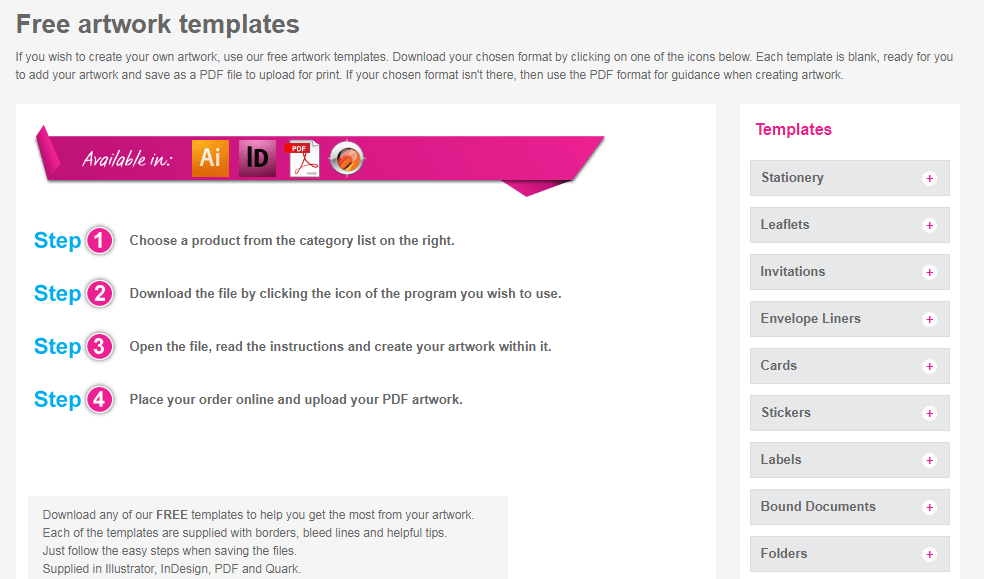
Tip: Although templates are meant to be edited by the users, you can still find a way to leave your branding in there by limiting the editing capabilities.
Difficulty Level: 1.5
- Cheat Sheets
Compared to most downloadable documents, cheat sheets are easier to execute. It’s usually just a list of concepts, terminologies, sizes, etc. about a specific subject. Most cheat sheets are around 1 to 3 pages only.
The objective of a cheat sheet is to be saved or printed to serve as a quick reference, so you have to design yours in such a way that it can be quickly scanned.
Check out Marketo’s cheat sheets for any digital marketing-related topic.

Difficulty Level: 1.5
- Tip Sheets
For industries where weekly or monthly tips are helpful, tip sheets can be a potent form of content. Tip sheets are popular for companies in the financial sector, but it can also be applicable to any industry as long as you provide actionable advice for your audience.
For example, ITD, a soft skills training provider gives out free tip sheets for communication, assertiveness, and presentation skills to give readers idea on the company’s expertise.

Difficulty Level: 1.5
- eBook
The term ebook is a broad term used to describe any publication available in the digital format (usually a PDF). Ebooks used in content marketing are always marketed as real books only published in a digital format. The goal of most ebooks is to provide extensive information that the audience can consume using their own devices even without internet connection.
With the proliferation of free ebooks in recent years, marketing them has become more difficult. This is where great topic generation comes in. From the title alone, your readers should immediately see the value in reading your ebook. It should also be designed properly to give your audience the actual “book reading” experience.
Check out the following Spiralytics ebooks for some inspiration:
Advanced Facebook Advertising Tips and Techniques for B2B Companies
Business Blogging for More Targeted Traffic and Leads
A Guide to Evaluating Your SEO Strategy for B2B Lead Generation
Tip: If you’re planning to release a series of ebooks, create and follow a template to reduce the production time and be consistent with your branding.
Difficulty Level: 2.5
- White Paper
White papers were originally produced by government bodies to give information or address an issue. Nowadays, a white paper is a specific type of ebook produced to convince readers about the superiority of a specific service product or service. They are typically framed to answer specific problems of the audience with the support of some data.
Unlike generic research, white papers are more skewed in favor of the company publishing the material, as it tries to convince the readers that the product or service the company is offering is the best solution to the reader’s problems.
Difficulty Level: 2.5
- Magazines
Similar to ebooks, digital magazines don’t have to be as thick as regular magazines. However, you also have the option to create as many pages as you like. You can opt to make it flippable online using “Flippagemaker” or make it printable.
Ezines are usually applicable to B2C companies but some B2B companies have also produced successful ones. Take a cue from the accounting firm PWc, which publishes a magazine for both their internal and external audiences.

Just make sure your magazine content is different from the content available on your blog or else, your readers might not be interested to download them. The general practice is to share industry news or lighter topics about the industry and compile interesting images if your industry is highly visual.
Difficulty Level: 2.5
- Reports
Banks like Security Bank regularly release performance reports to update their customers with the current performance of their funds. But they are not the only companies that can share reports with their audience. As long as your industry is heavily reliant on data, you can publish reports regularly.

Tip: Not all of your audience has the technical know-how to understand your reports. If there’s an opportunity to turn your data into graphs and charts, then do so. Your readers will thank you.
Difficulty Level: 1.5
- Action Plans
Compared to checklists, action plans are more detailed documents that show a step-by-step process one has to take to accomplish a task. It usually includes the timeframe for each subtask, desired outcome, materials needed, and assigned personnel.
Here’s an example from WorkSafe – Sample Occupational Health and Safety Action plan for Community Services Sector.

Difficulty Level: 2
Interactive Formats
- Polls and Surveys
Polls are defined as a one-time question to get the pulse of your audience about a single issue.
Surveys, on the other hand, are sets of questions designed to gather data about a bigger problem or subject matter.
Polls and surveys are usually self-serving content that benefit the organization. With modern content marketing, you can create polls and surveys that will also benefit the readers. Ask them what they like and don’t like about your company, their suggestions for improvement, and the types of content they find helpful.

Tip: Make your surveys short to avoid drop-offs. You may also offer an incentive in the form of a product sample, product testing, or a discount to motivate them.
Difficulty Level: 1.5
- Quizzes
A favorite among pop culture content marketers, quizzes are a great way to engage your audience using very little effort. All it takes is formulating questions about a topic then setting up the quiz on your site.
Whether you opt for factual or personality quizzes, there are some things the most popular quizzes have in common – they are fun and easy to take, they make the takers feel better about themselves or expand their knowledge, and they can be used to collect leads and grow your audience.
Some quizzes are factual in nature similar to the Fire Safety Quiz of Red Cross while some are based on a prejudgment of the writer like most personality quizzes (see: What’s Your Content Marketing Spirit Animal).

Tip: Creating a quiz can help attract the social media friends of your audience, so make sure that quiz results are shareable. Sometimes, quizzes can be a part of a regular blog post like a how-to post or a listicle. You can place the quiz at the top, middle, or end to engage visitors. An example is this blog post from DoFasting. If you scroll to the bottom, you will notice a quiz. This helps not only engage visitors but also generate leads as people can sign up for a report after taking the quiz.
Difficulty Level: 2
- Games
Google, through its homepage doodles, has introduced games that bring awareness to global issues and celebrations. A few of the most iconic ones are Pac-Man, 2017 Valentines Day, and 2016 Halloween.

Just like Google, you can produce games that will not only entertain your audience but also educate them about your product or a social cause your company is championing.
Tip: Social sharing is a very important aspect for Online Casual games. Include sharing options on the every time someone finishes the game.
Difficulty Level: 5
- Live Chats
This is not the typical live chat plugin where site visitors can ask questions about the company or the product. This live chat is an interactive event where one of your key employees, executives, partners, or industry influencers will answer questions from the audience in real-time usually through video chat.
This has become a popular content with the rise of live streaming capabilities of social media apps like Facebook Live, Instagram Live, and Periscope, but you can host this on your site too.
Tip: Focus on a single topic on every live chat to limit the questions.
Difficulty Level: 2
- Custom Apps
Helping your audience should be one of your priority goals in content marketing. While providing information is extremely helpful, giving them actual solutions to their problems can be more effective. Free custom apps can help you achieve this goal.
The best example for helpful custom apps is InStyle’s HollyWood Makeover Tool, which eliminates the dilemma of customers on how they will look like in the hairstyles of their favorite celebrities.

For content marketers, CoSchedule and ShareThrough’s Headline Analyzers are the best custom apps for testing content titles.
Tip: Although you are offering these apps for free, you can always look for opportunity how it can further help you as a brand. Most of the time, the results of free apps can only be downloaded if shared on social media.
Difficulty Level: 5
- Calculators, Estimators
Most of the time, the only reason your readers are not converting into customers is their uncertainty about the Return on Investment in case they purchase your product or avail of your service. Thankfully, you can build your case by creating calculators or estimators.
Calculators and estimators can be in excel format, but are more effective as online apps just like Microsoft Office 365. Some calculators and estimators are used purely for educational purposes like Nielsen’s Socio-economic Classification ABCDE, which estimates the class where you belong to. The BIR Tax Calculator, on the other hand, was created to increase the awareness of Filipinos on the impact of the new tax reform.

Difficulty Level: 4.5
- Branching stories
Branching stories are basically the digital format of “choose your own adventure books” that were so popular in the 80s. It usually starts with an introduction of a main character who will then be given two options to move forward with the story until the reader reaches an end. Readers can go back and choose another option to achieve a different ending.
The most recent samples of these are Stepehen Colbert’s game on the CBS website, which was used to promote his late night show. Buzzfeed also came up with Can You Survive The Battle Of Hogwarts? Game to celebrate one of the most devastating and iconic fictional events.
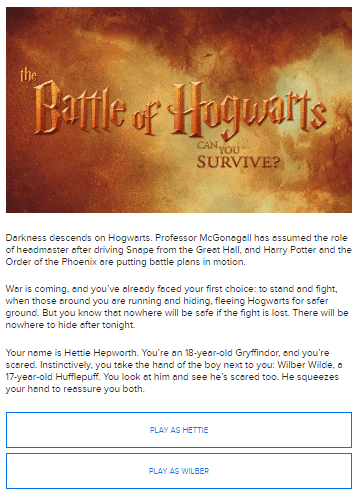
Difficulty Level: 5
Any other interesting content formats you’ve seen? Be sure to let us know in the comments!





